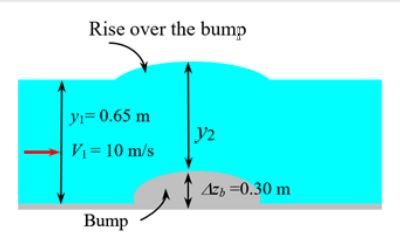
The change in water level.
Whether the flow over the bump is sub or supercritical.
Answer to Problem 100P
The rise in water level over the bump is
The flow over the bump is supercritical.
Explanation of Solution
Given information:
Velocity of water flow is
Write the expression for the Froude number.
Here, the velocity of fluid is
The figure below shows the rise over the bump.

Figure-(1)
Write the expression for the critical flow depth.
Write the expression for the specific energy before the bump.
Write the expression for the specific energy over the bump.
Here, the height of the bump is
Write the expression for the critical specific energy.
Here the critical flow depth is
Write the expression to calculate the flow over the bump.
Here, the specific energy before the bump is
Write the expression for the rise over the bump.
Calculation:
Substitute
The Froude number is greater than
Substitute
Substitute
Substitute
Substitute
Substitute
After solving by iteration method three roots of the
A physical meaningful root of the equation is
Substitute
Substitute
The Froude number is greater than
Conclusion:
The rise in water level over the bump is
The flow over the bump is supercritical.
Want to see more full solutions like this?
Chapter 13 Solutions
Fluid Mechanics: Fundamentals and Applications
- Water is released from a 12-m-deep reservoir into a 6-m-wide open channel through a sluice gate with a 1-m-high opening at the channel bottom. If the flow depth downstream from the gate is measured to be 3 m, determine the rate of discharge through the gate.arrow_forwardWater flows steadily in a 1.75-m-wide rectangular channel at a rate of 0.85 m3/s. If the flow depth is 0.40 m, determine the flow velocity and if the flow is subcritical or supercritical. Also determine the alternate flow depth if the character of flow were to change.arrow_forwardThe flow rate of water in a 10-m-wide horizontal channel is being measured using a 1.3-m-high sharp-crested rectangular weir that spans across the channel. If the water depth upstream is 3.4 m, determine the flow rate of water.arrow_forward
- A 3-ft-diameter semicircular channel made of unfinished concrete is to transport water to a distance of 1 miuniformly. If the flow rate is to reach 90 ft3/s when the channel is full, determine the minimum elevation difference across the channel.arrow_forwardHow does uniform flow differ from nonuniform flow in open channels? In what kind of channels is uniform flow observed?arrow_forwardWhen is the flow in an open channel said to be uniform? Under what conditions will the flow in an open channel remain uniform?arrow_forward
- Water at 20°C flows at a depth of 0.4 m with an average velocity of 4 m/s in a rectangular channel. Determine the specific energy of the water and whether the flow is subcritical or supercritical.arrow_forwardWater flows in a canal at an average velocity of 6 m/s. Determine if the flow is subcritical or supercritical for flow depths of (a) 0.2 m, (b) 2 m, and (c) 1.63 m.arrow_forwardWhat is critical depth in open-channel flow? For a given average flow velocity, how is it determined?arrow_forward
- Consider the flow of water in a wide channel. Determine the speed of a small disturbance in the flow if the flow depth is (a) 50 cm and (b) 100 cm. What would your answer be if the fluid were oil?arrow_forwardHow is the specific energy of a fluid flowing in an open channel defined in terms of heads?arrow_forwardHow does the pressure change along the free surface in an open-channel flow?arrow_forward
 Elements Of ElectromagneticsMechanical EngineeringISBN:9780190698614Author:Sadiku, Matthew N. O.Publisher:Oxford University Press
Elements Of ElectromagneticsMechanical EngineeringISBN:9780190698614Author:Sadiku, Matthew N. O.Publisher:Oxford University Press Mechanics of Materials (10th Edition)Mechanical EngineeringISBN:9780134319650Author:Russell C. HibbelerPublisher:PEARSON
Mechanics of Materials (10th Edition)Mechanical EngineeringISBN:9780134319650Author:Russell C. HibbelerPublisher:PEARSON Thermodynamics: An Engineering ApproachMechanical EngineeringISBN:9781259822674Author:Yunus A. Cengel Dr., Michael A. BolesPublisher:McGraw-Hill Education
Thermodynamics: An Engineering ApproachMechanical EngineeringISBN:9781259822674Author:Yunus A. Cengel Dr., Michael A. BolesPublisher:McGraw-Hill Education Control Systems EngineeringMechanical EngineeringISBN:9781118170519Author:Norman S. NisePublisher:WILEY
Control Systems EngineeringMechanical EngineeringISBN:9781118170519Author:Norman S. NisePublisher:WILEY Mechanics of Materials (MindTap Course List)Mechanical EngineeringISBN:9781337093347Author:Barry J. Goodno, James M. GerePublisher:Cengage Learning
Mechanics of Materials (MindTap Course List)Mechanical EngineeringISBN:9781337093347Author:Barry J. Goodno, James M. GerePublisher:Cengage Learning Engineering Mechanics: StaticsMechanical EngineeringISBN:9781118807330Author:James L. Meriam, L. G. Kraige, J. N. BoltonPublisher:WILEY
Engineering Mechanics: StaticsMechanical EngineeringISBN:9781118807330Author:James L. Meriam, L. G. Kraige, J. N. BoltonPublisher:WILEY





